一、微服务架构下的问题
在大型系统的微服务化架构中,一个系统会被拆分成许多模块。这些模块负责不同的功能,组合成系统,最终可以提供丰富的功能。在这种架构中,一次请求往往需要涉及多个服务。互联网应用构建在不同的软件模块集上,这些软件模块,有可能是由不同的团队开发、可能使用不同的编程语言来实现、有可能部署在了几千台服务器上,横跨多个不同的数据中心,也就意味着这种架构形式也会存在一些问题:
- 如何快速发现问题?
- 如何判断故障影响范围?
- 如何梳理服务依赖以及依赖的合理性?
- 如何分析链路性能问题以及实现容量规划?
分布式链路追踪(Distributed Tracing),就是将一次分布式请求还原成调用链路,进行日志记录,性能监控,并将一次分布式请求的调用情况集中展示。比如各个服务节点上的耗时、请求具体到达哪台机器上、每个服务节点的请求状态等等。
目前业界比较流行的链路追踪系统如:Twitter 的 Zipkin,阿里的鹰眼,美团的 Mtrace,大众点评的 cat 等,大部分都是基于 Google 发表的 Dapper。Dapper 阐述了分布式系统,特别是微服务架构中链路追踪的概念、数据表示、埋点、传递、收集、存储与展示等技术细节。
二、Sleuth 概述
2.1 简介
SpringCloud Sleuth 主要功能就是在分布式系统中提供追踪的解决方案,并且兼容支持了 Zipkin,只需要在 pom 文件中引入相应的依赖即可。
2.2 相关概念
SpringCloud Sleuth 为 SpringCloud 提供了分布式根据的解决方案。它大量借用了 Google Dapper 的设计。先来了解一下 Sleuth 中的术语和相关概念。
SpringCloud Sleuth 采用的是 Google 的开源项目 Dapper 的专业术语。
- Span:基本工作单元,例如,在一个新建的 span 中发送一个 RPC 等同于发送一个回应请求给 RPC,span 通过一个 64 位 ID 唯一标识,trace 以另一个 64 位 ID 表示,span 还有其他数据信息,比如摘要、时间戳事件、关键值注释(tags)、span 的 ID、以及进度 ID(通常是 IP 地址)
- Trace:一系列 spans 组成的一个树状结构,例如,如果你正在跑一个分布式大数据工程,你可能需要创建一个 trace
- Annotation:用来及时记录一个事件的存在,一些核心 annotations 用来定义一个请求的开始和结束。
cs – Client Sent,客户端发起一个请求,这个 annotation 描述了这个 span 的开始
sr – Server Received -服务端获得请求并准备开始处理它,如果将其sr减去cs时间戳便可得到网络延迟
ss – Server Sent -注解表明请求处理的完成(当请求返回客户端),如果ss减去sr时间戳便可得到服务端需要的处理请求时间
cr – Client Received -表明span的结束,客户端成功接收到服务端的回复,如果cr减去cs时间戳便可得到客户端从服务端获取回复的所有所需时间
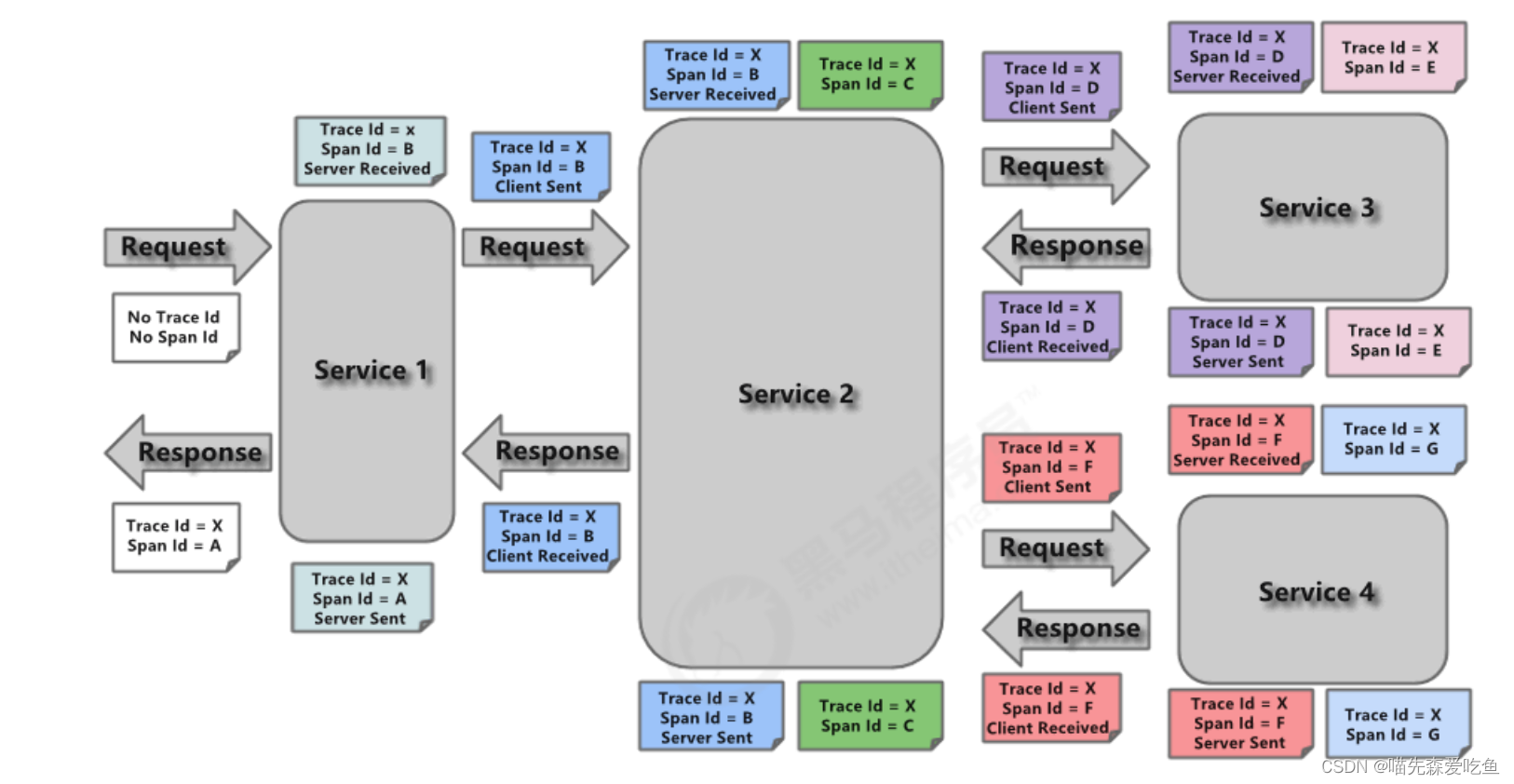
span表示调用链路来源,通俗的理解span就是一次请求信息
trace 可以理解为整个调用链路。
三、Zipkin 概述
Zipkin 是 Twitter 的一个开源项目,它基于 Google Dapper 实现,致力于收集服务的定时数据,以解决微服务架构中的延迟问题,包括数据的收集、存储、查找和展现。我们可以使用它来收集各个服务器上请求链路的跟踪数据,并通过它提供的 REST API 接口来辅助我们查询跟踪数据,以实现对分布式系统的监控程序,从而及时地发现系统中出现的延迟升高问题,并找出系统性能瓶颈的根源。除了面向开发的 API 接口之外,它也提供了方便的 UI 组件来帮助我们直观的搜索跟踪信息和分析请求链路明细,比如:可以查询某段时间内向各用户请求的处理时间等。Zipkin 提供了可插拔数据存储方式:In-Memory、MySQL、Cassandra 以及 Elasticsearch。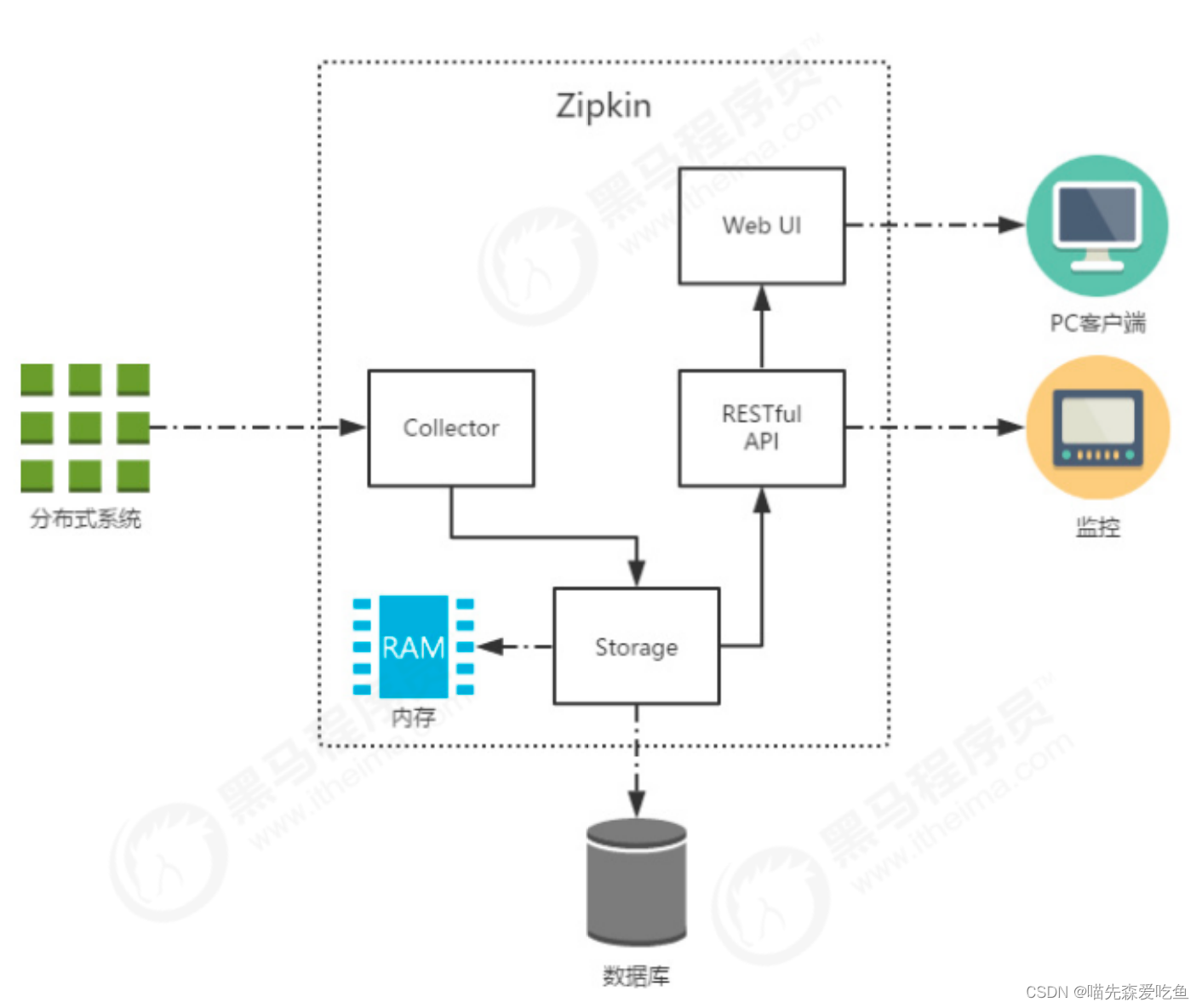
上图展示了 Zipkin 的基础架构,它主要由 4 个核心组件构成:
- Collector:收集器组件,它主要用于处理从外部系统发送过来的跟踪信息,将这些信息转换为 Zipkin 内部处理的 Span 格式,以支持后续的存储、分析、展示等功能。
- Storage:存储组件,它主要对处理收集器接收到的跟踪信息,默认会将这些信息存储在内存中,我们也可以修改此存储策略,铜鼓哦使用其他存储组件将跟踪信息存储到数据库中。
- RESTful API:API 组件,它主要用来提供外部访问接口。比如给客户端展示跟踪信息,或是外界系统访问以实现监控等。
- Web UI:UI 组件,基于 API 组件实现的上层应用。通过 UI 最贱用户可以方便而又直观地查询和分析跟踪信息。
Zipkin 分为两端,一个是 Zipkin 服务端,一个是 Zipkin 客户端,客户端也就是微服务的应用。
客户端会配置服务端的 URL 地址,一旦发生服务间的调用的时候,会被配置在微服务里面的 Sleuth 的监听器监听,并生成相应的 Trace 和 Span 信息发送给服务端。
发送的方式主要有两种,一种是 HTTP 报文的方式,还有一种是消息总线的方式,如 RabbitMQ。
不论哪种方式,我们都需要:
- 一个 Eureka 服务注册中心
- 一个 Zipkin 服务端
- 多个微服务,这些微服务中配置 Zipkin 客户端
四、Zipkin Server 的部署和配置
4.1 Zipkin Server 下载
从 SpringBoot 2.0 开始,官方就不再支持使用自建 Zipkin Server 的方式进行服务链路追踪,而是直接提供了编译好的 jar 包来给我们使用。可以从官网上下载 Zipkin 的 Web UI,下载地址:https://dl.bintray.com/openzipkin/maven/io/zipkin/java/zipkin-server/,我们这里下载的是zipkin-server-2.12.9-exec.jar
4.2 启动
在命令行输入java -jar zipkin-server-2.12.9-exec.jar 启动 Zipkin Server。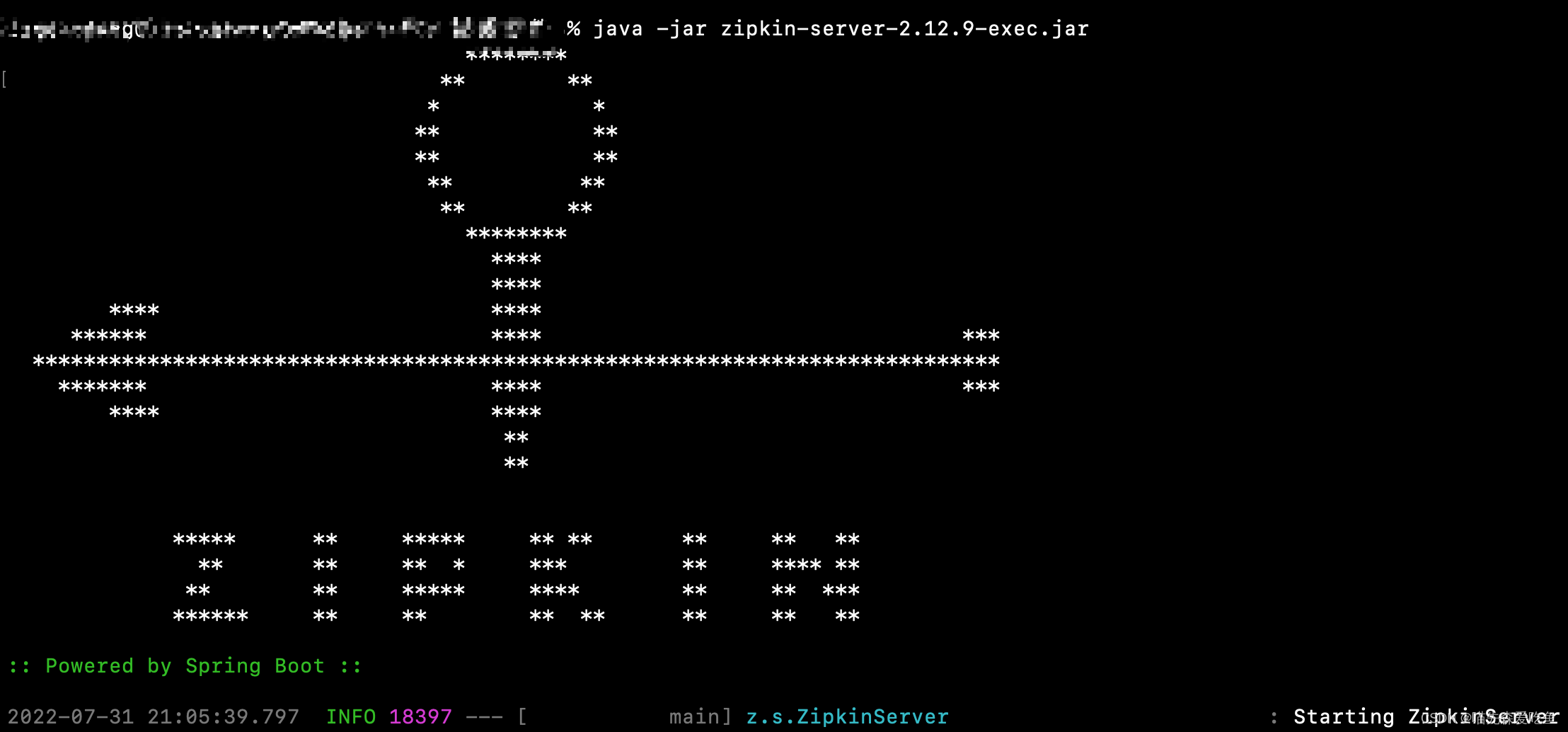
- 默认 Zipkin Server 的请求端口为 9411
- Zipkin Server 的启动参数可以通过官方提供的yml 配置文件查找
- 在浏览器输入
http://127.0.0.1:9411即可进入到 Zipkin Sever 的管理后台
五、客户端 Zipkin + Sleuth 整合
5.1 客户端 payment8001 以及 order80 添加依赖
<dependency><groupId>org.springframework.cloud</groupId><artifactId>spring-cloud-starter-zipkin</artifactId></dependency>5.2 修改客户端的配置文件
修改 8001 及 80 服务的 application.yml,增加 zipkin 以及 sleuth 相关配置。
spring:zipkin:base-url: http://127.0.0.1:9411# zipkin server 的请求地址sender:type: web# 请求方式,默认以 http 的方式向 Zipkin server 发送追踪数据sleuth:sampler:probability:1.0# 采样的百分比全部配置如下:
8001:
server:port:8001spring:application:name: cloud-payment-servicezipkin:base-url: http://127.0.0.1:9411# zipkin server 的请求地址sender:type: web# 请求方式,默认以 http 的方式向 Zipkin server 发送追踪数据sleuth:sampler:probability:1.0# 采样的百分比datasource:type: com.alibaba.druid.pool.DruidDataSource# 当前数据源操作类型driver-class-name: com.mysql.cj.jdbc.Driver# mysql 驱动包url: jdbc:mysql://localhost:3306/db2019?useUnicode=true&characterEncoding=utf-8&useSSL=falseusername: rootpassword: rootmybatis:mapper-locations: classpath:mapper/*.xmltype-aliases-package: com.atguigu.springcloud.entities# 所有 Entity 别名类所在包eureka:client:register-with-eureka:true#表示是否将自己注册进EurekaServer,默认为truefetch-registry:true# 是否从 EurekaServer 抓取已有的注册信息,默认为true。单节点无所谓,集群必须设置为true,才能配合ribbon使用负载均衡service-url:defaultZone: http://localhost:7001/eurekainstance:instance-id: payment8001prefer-ip-address:truelease-renewal-interval-in-seconds:1# 客户端向服务端发送心跳的时间间隔,单位为秒(默认是30秒)lease-expiration-duration-in-seconds:2# 服务端在收到最后一次心跳后等待时间上限,单位为秒(默认是90秒),超时将剔除80:
server:port:80spring:application:name: cloud-order-servicezipkin:base-url: http://127.0.0.1:9411# zipkin server 的请求地址sender:type: web# 请求方式,默认以 http 的方式向 Zipkin server 发送追踪数据sleuth:sampler:probability:1.0# 采样的百分比eureka:client:register-with-eureka:truefetch-registry:trueservice-url:defaultZone: http://localhost:7001/eurekainstance:instance-id: order80prefer-ip-address:true通过spring.zipkin.base-url 来指定 Zipkin server 的地址
通过spring.sleuth.sampler.probability 来指定需采样的百分比,默认为 0.1,即 10%,这里配置 1,表示记录全部的 Sleuth 信息,是为了收集到更多的数据(仅供测试用)。在分布式系统中,过于频繁的采用会影响系统性能,所以这里配置需要采用一个合适的值。
5.3 测试
依次启动eureka7001/8001/80,浏览器访问:http://127.0.0.1/consumer/payment/get/31,打开 Zipkin service 控制台。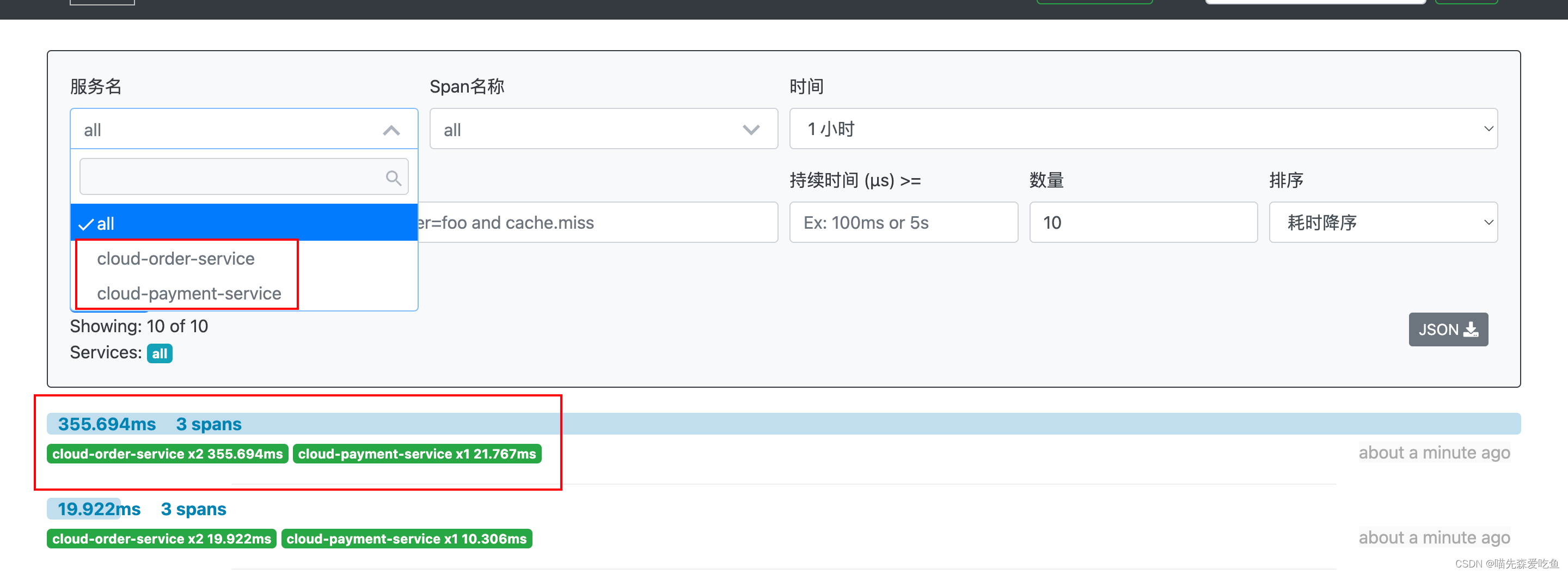
单击该 trace 可以看到请求的细节:
六、存储跟踪数据
Zipkin Sever 默认是将追踪数据信息保存到内存,这种方式不适合生产环境。因为一旦 Service 关闭重启或者服务崩溃,就会导致历史数据消失。Zipkin 支持将追踪数据持久化到 MySQL 数据库或者存储到 elasticsearch 中。这里以 MySQL 为例。
6.1 准备数据库
可以从官网找到 Zipkin Server 持久化到 MySQL 的数据库脚本。
createdatabaseifnotexists zipkin;use zipkin;CREATETABLEIFNOTEXISTS zipkin_spans(`trace_id_high`BIGINTNOTNULLDEFAULT0COMMENT'If non zero, this means the trace uses 128 bit traceIds instead of 64 bit',`trace_id`BIGINTNOTNULL,`id`BIGINTNOTNULL,`name`VARCHAR(255)NOTNULL,`parent_id`BIGINT,`debug`BIT(1),`start_ts`BIGINTCOMMENT'Span.timestamp(): epoch micros used for endTs query and to implement TTL',`duration`BIGINTCOMMENT'Span.duration(): micros used for minDuration and maxDuration query')ENGINE=InnoDB ROW_FORMAT=COMPRESSEDCHARACTERSET=utf8COLLATE utf8_general_ci;ALTERTABLE zipkin_spansADDUNIQUEKEY(`trace_id_high`,`trace_id`,`id`)COMMENT'ignore insert on duplicate';ALTERTABLE zipkin_spansADDINDEX(`trace_id_high`,`trace_id`,`id`)COMMENT'for joining with zipkin_annotations';ALTERTABLE zipkin_spansADDINDEX(`trace_id_high`,`trace_id`)COMMENT'for
getTracesByIds';ALTERTABLE zipkin_spansADDINDEX(`name`)COMMENT'for getTraces and
getSpanNames';ALTERTABLE zipkin_spansADDINDEX(`start_ts`)COMMENT'for getTraces
ordering and range';CREATETABLEIFNOTEXISTS zipkin_annotations(`trace_id_high`BIGINTNOTNULLDEFAULT0COMMENT'If non zero, this means
the trace uses 128 bit traceIds instead of 64 bit',`trace_id`BIGINTNOTNULLCOMMENT'coincides with zipkin_spans.trace_id',`span_id`BIGINTNOTNULLCOMMENT'coincides with zipkin_spans.id',`a_key`VARCHAR(255)NOTNULLCOMMENT'BinaryAnnotation.key or
Annotation.value if type == -1',`a_value`BLOBCOMMENT'BinaryAnnotation.value(), which must be smaller
than 64KB',`a_type`INTNOTNULLCOMMENT'BinaryAnnotation.type() or -1 if
Annotation',`a_timestamp`BIGINTCOMMENT'Used to implement TTL; Annotation.timestamp
or zipkin_spans.timestamp',`endpoint_ipv4`INTCOMMENT'Null when Binary/Annotation.endpoint is
null',`endpoint_ipv6`BINARY(16)COMMENT'Null when Binary/Annotation.endpoint
is null, or no IPv6 address',`endpoint_port`SMALLINTCOMMENT'Null when Binary/Annotation.endpoint is
null',`endpoint_service_name`VARCHAR(255)COMMENT'Null when
Binary/Annotation.endpoint is null')ENGINE=InnoDB ROW_FORMAT=COMPRESSEDCHARACTERSET=utf8COLLATE
utf8_general_ci;ALTERTABLE zipkin_annotationsADDUNIQUEKEY(`trace_id_high`,`trace_id`,`span_id`,`a_key`,`a_timestamp`)COMMENT'Ignore insert on duplicate';ALTERTABLE zipkin_annotationsADDINDEX(`trace_id_high`,`trace_id`,`span_id`)COMMENT'for joining with zipkin_spans';ALTERTABLE zipkin_annotationsADDINDEX(`trace_id_high`,`trace_id`)COMMENT'for getTraces/ByIds';ALTERTABLE zipkin_annotationsADDINDEX(`endpoint_service_name`)COMMENT'for getTraces and getServiceNames';ALTERTABLE zipkin_annotationsADDINDEX(`a_type`)COMMENT'for getTraces';ALTERTABLE zipkin_annotationsADDINDEX(`a_key`)COMMENT'for getTraces';ALTERTABLE zipkin_annotationsADDINDEX(`trace_id`,`span_id`,`a_key`)COMMENT'for dependencies job';CREATETABLEIFNOTEXISTS zipkin_dependencies(`day`DATENOTNULL,`parent`VARCHAR(255)NOTNULL,`child`VARCHAR(255)NOTNULL,`call_count`BIGINT)ENGINE=InnoDB ROW_FORMAT=COMPRESSEDCHARACTERSET=utf8COLLATE
utf8_general_ci;ALTERTABLE zipkin_dependenciesADDUNIQUEKEY(`day`,`parent`,`child`);6.2 配置启动服务端
java-jar zipkin-server-2.12.9-exec.jar--STORAGE_TYPE=mysql--
MYSQL_HOST=127.0.0.1--MYSQL_TCP_PORT=3306--MYSQL_DB=zipkin--MYSQL_USER=root--MYSQL_PASS=111111- STORAGE_TYPE : 存储类型
- MYSQL_HOST: mysql主机地址
- MYSQL_TCP_PORT:mysql端口
- MYSQL_DB: mysql数据库名称
- MYSQL_USER:mysql用户名
- MYSQL_PASS :mysql密码
配置好服务端之后,可以在浏览器请求几次。回到数据库查看会发现数据已经持久化到mysql中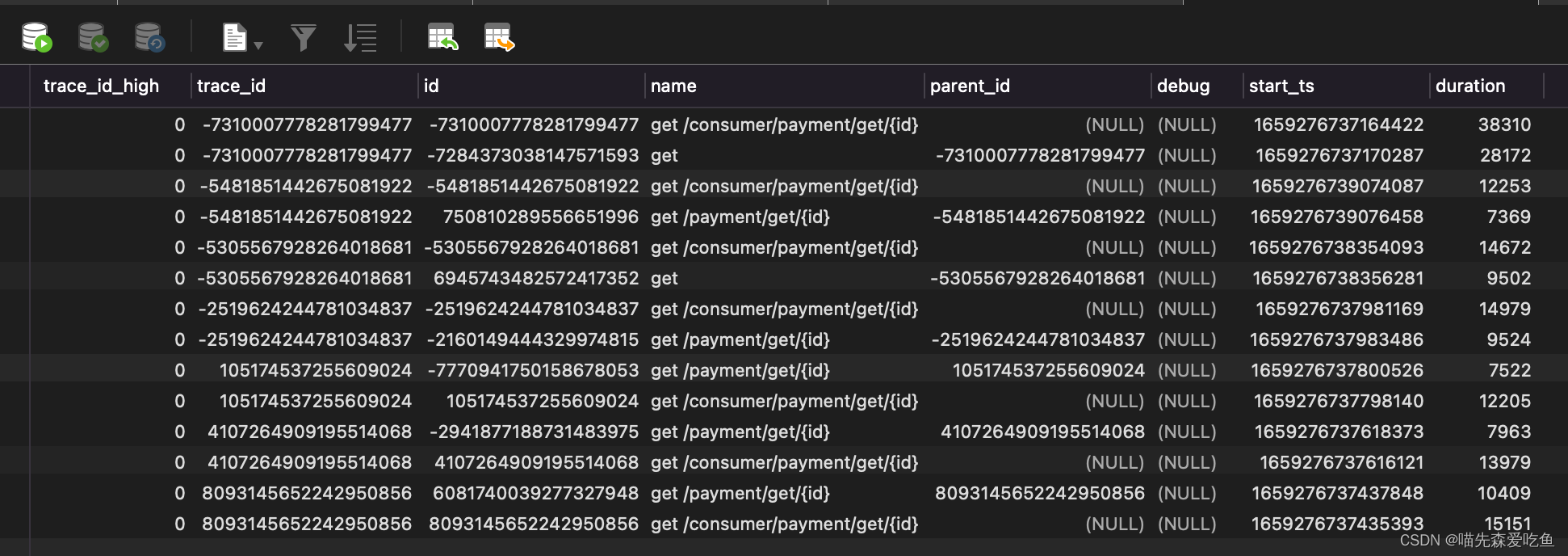
七、基于消息中间件收集数据
在默认情况下,Zipkin 客户端和 Server 之间是使用 HTTP 请求的方式进行通信(即同步的请求方式),在网络波动、Server 端异常等情况下可能存在信息收集不及时的问题。Zipkin 支持与 RabbitMQ 整合,完成异步消息传输。
加了 MQ 之后,通信过程如下如所示:
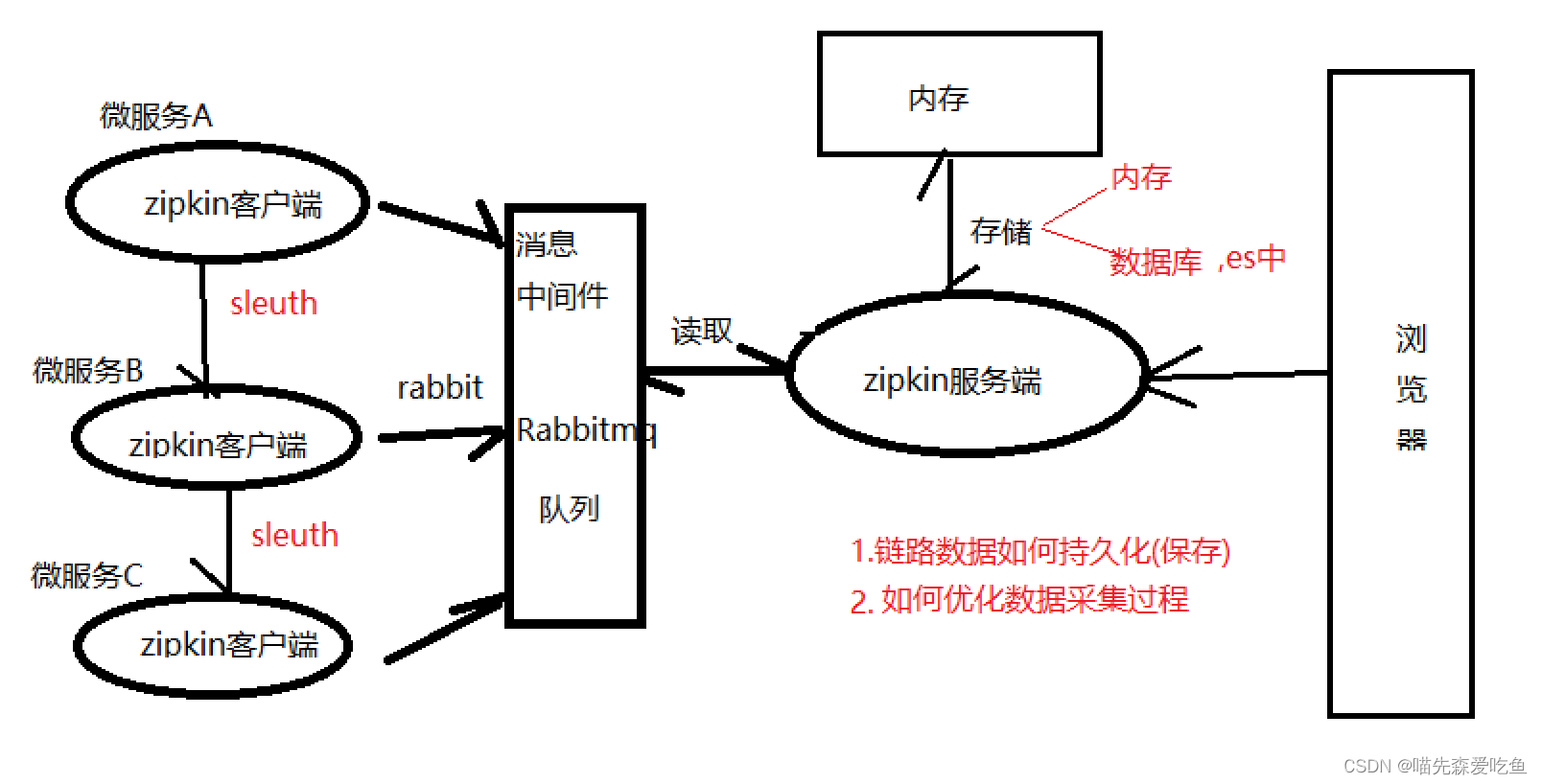
7.1 RabbitMQ 的安装与启动
略
7.2 服务端启动
java-jar zipkin-server-2.12.9-exec.jar--RABBIT_ADDRESSES=127.0.0.1:5672- RABBIT_ADDRESSES : 指定RabbitMQ地址
- RABBIT_USER: 用户名(默认guest)
- RABBIT_PASSWORD : 密码(默认guest)
启动Zipkin Server之后,我们打开RabbitMQ的控制台可以看到多了一个Queue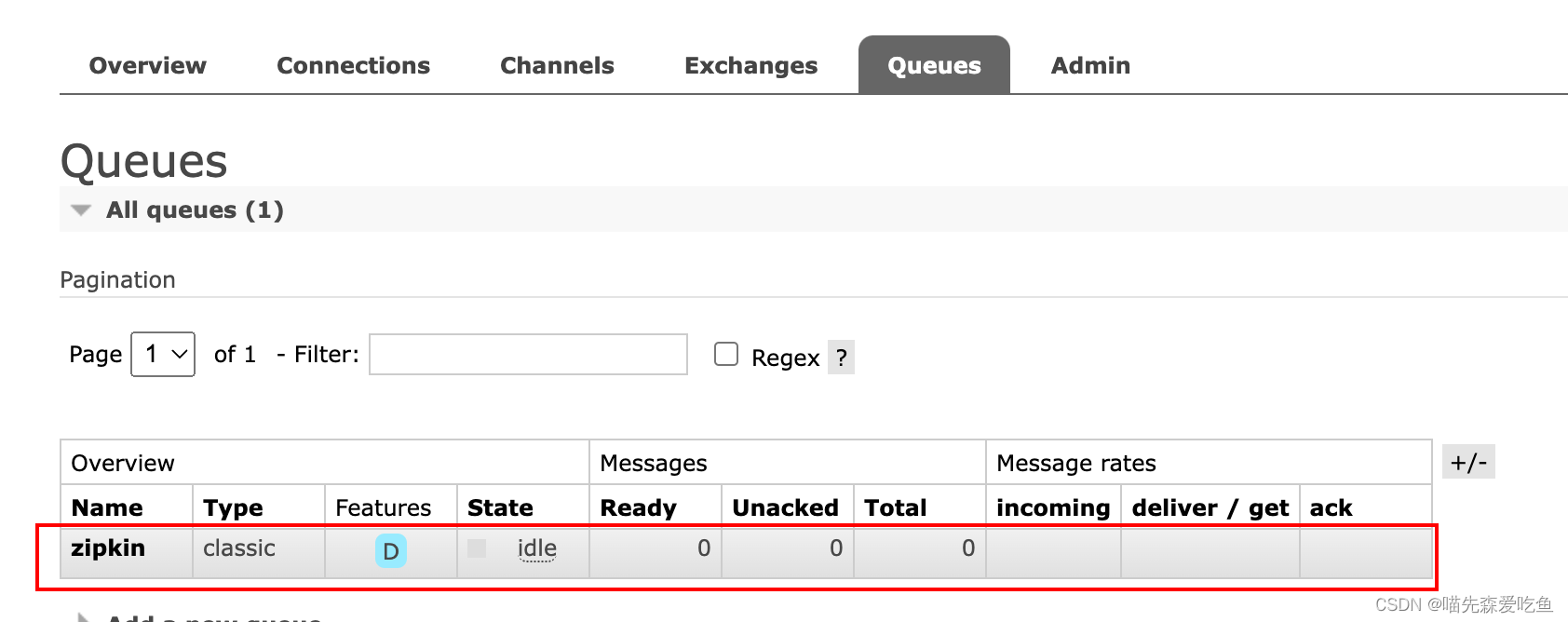
其中 zipkin 就是为我们自动创建的 Queue 队列。
7.3 客户端配置
7.3.1 配置依赖
<dependency><groupId>org.springframework.amqp</groupId><artifactId>spring-rabbit</artifactId></dependency><dependency><groupId>org.springframework.cloud</groupId><artifactId>spring-cloud-starter-zipkin</artifactId></dependency>导入 spring-rabbit 依赖,是 Spring 提供的对 Rabbit 的封装,客户端会根据配置自动的生产消息并发送到目标队列中。
7.3.2 配置消息中间件 RabbitMQ 地址等信息
spring:zipkin:base-url: http://127.0.0.1:9411# zipkin server 的请求地址sender:type: rabbit# type: web # 请求方式,默认以 http 的方式向 Zipkin server 发送追踪数据sleuth:sampler:probability:1.0# 采样的百分比rabbitmq:host: localhostport:5672username: guestpassword: guestlistener:# 这里配置了重试策略direct:retry:enabled:truesimple:retry:enabled:true- 修改消息的投递方式,改为 rabbit 即可。
- 添加 RabbitMQ 的相关配置。
7.3.3 创建配置类
packagecom.atguigu.springcloud.config;importcom.rabbitmq.client.ConnectionFactory;importorg.springframework.beans.factory.annotation.Autowired;importorg.springframework.boot.autoconfigure.amqp.RabbitProperties;importorg.springframework.context.annotation.Bean;importorg.springframework.context.annotation.Configuration;importzipkin2.reporter.Sender;importzipkin2.reporter.amqp.RabbitMQSender;@ConfigurationpublicclassZipkinConfig{@AutowiredprivateRabbitProperties rabbitProperties;@BeanSenderrabbitSender2(){ConnectionFactory connectionFactory=newConnectionFactory();
connectionFactory.setHost(rabbitProperties.getHost());
connectionFactory.setPort(rabbitProperties.getPort());
connectionFactory.setPassword(rabbitProperties.getPassword());
connectionFactory.setUsername(rabbitProperties.getUsername());returnRabbitMQSender.newBuilder().connectionFactory(connectionFactory).queue("zipkin").addresses(rabbitProperties.getHost()+":"+rabbitProperties.getPort()).build();}}如果不添加此配置类,服务 8001 和 80 在启动时会报如下错误:
Description:Parameter2 of method reporter inorg.springframework.cloud.sleuth.zipkin2.ZipkinAutoConfiguration required a bean of type 'zipkin2.reporter.Sender' that could not befound.
The following candidates were found but could not be injected:-Bean method 'kafkaSender' in 'ZipkinKafkaSenderConfiguration' not loaded because@ConditionalOnClass did not find requiredclass 'org.apache.kafka.common.serialization.ByteArraySerializer'-Bean method 'rabbitSender' in 'ZipkinRabbitSenderConfiguration' not loaded because@ConditionalOnBean(types:org.springframework.amqp.rabbit.connection.CachingConnectionFactory;SearchStrategy: all) did not find any beans of typeorg.springframework.amqp.rabbit.connection.CachingConnectionFactory-Bean method 'restTemplateSender' in 'ZipkinRestTemplateSenderConfiguration' not loaded becauseZipkinSenderorg.springframework.cloud.sleuth.zipkin2.sender.ZipkinRestTemplateSenderConfiguration rabbit sender type注意以上修改,服务 8001 和 80 均需要修改。
7.4 测试
关闭Zipkin Server,并随意请求连接。打开rabbitmq管理后台可以看到,消息已经推送到rabbitmq。 当Zipkin Server启动时,会自动的从rabbitmq获取消息并消费,展示追踪数据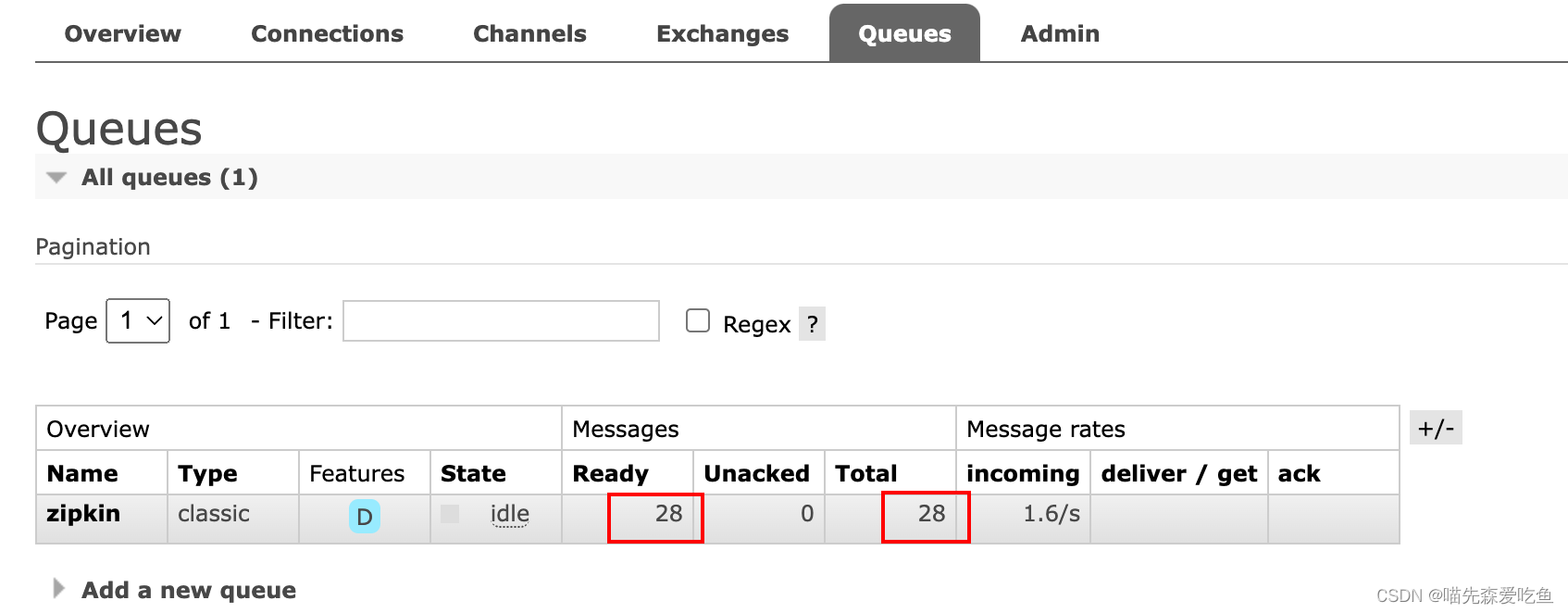
可以看到如下效果:
- 请求的耗时时间不会出现突然耗时特长的情况
- 当ZipkinServer不可用时(比如关闭、网络不通等),追踪信息不会丢失,因为这些信息会保存在 Rabbitmq 服务器上,直到Zipkin服务器可用时,再从Rabbitmq中取出这段时间的信息